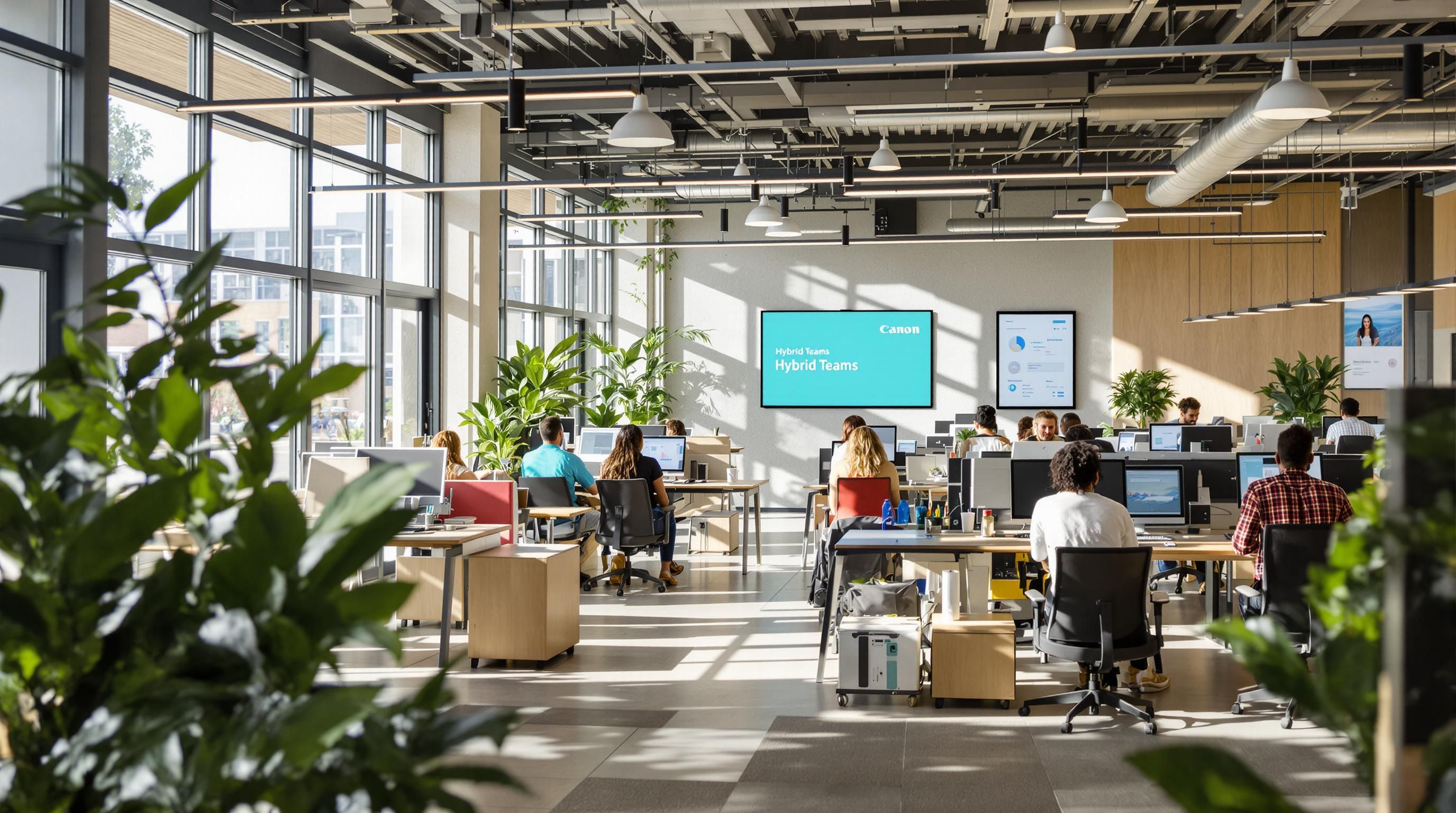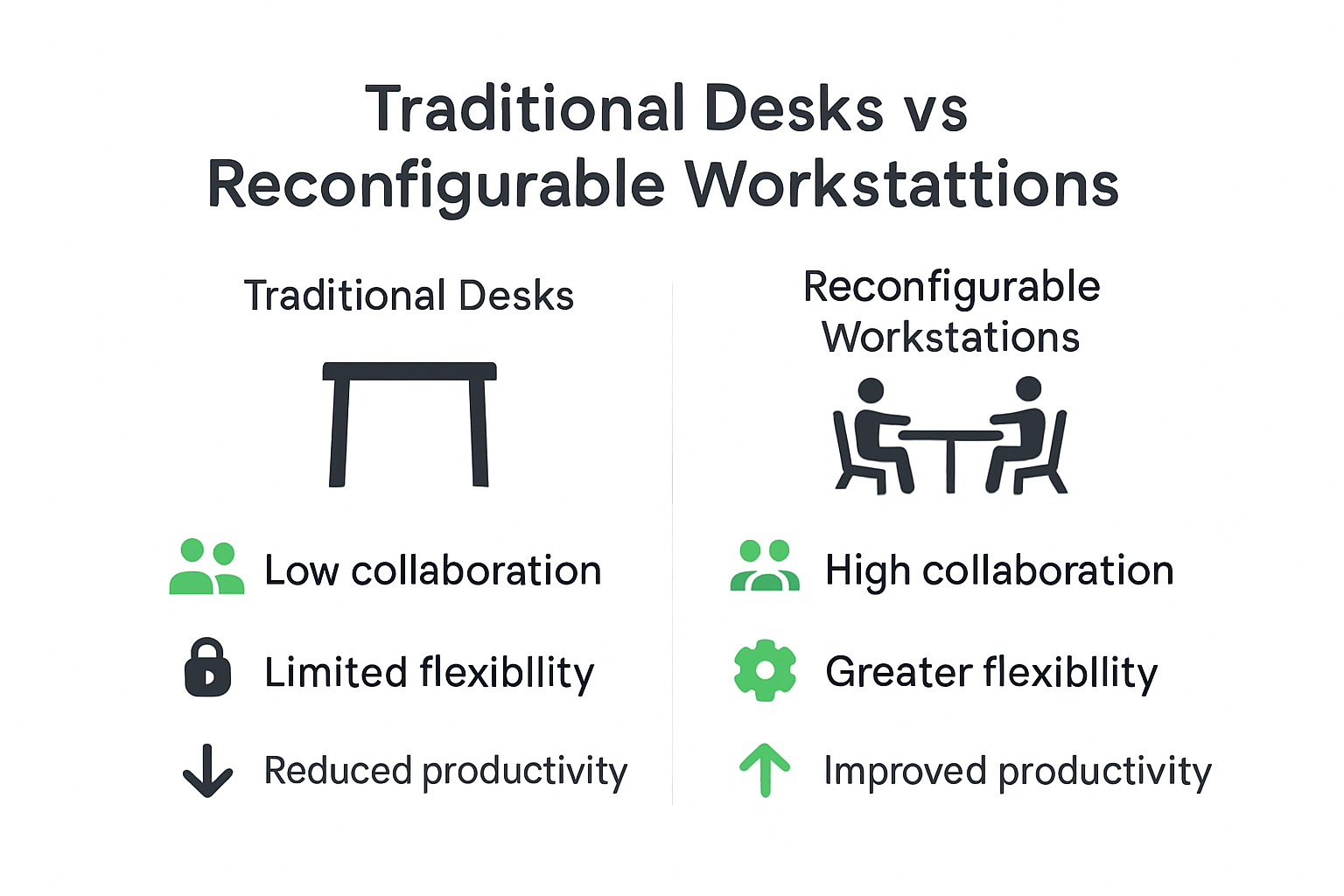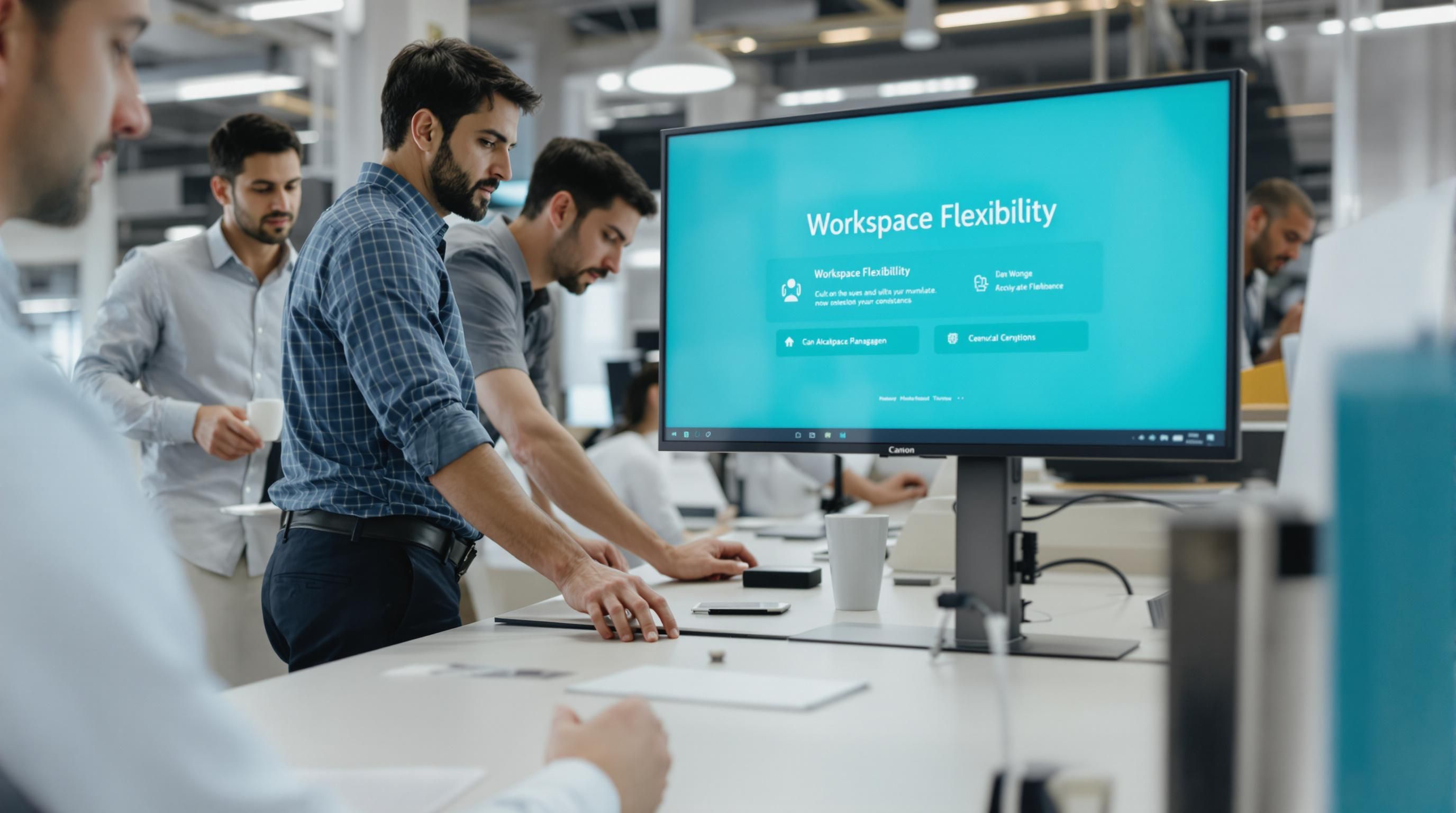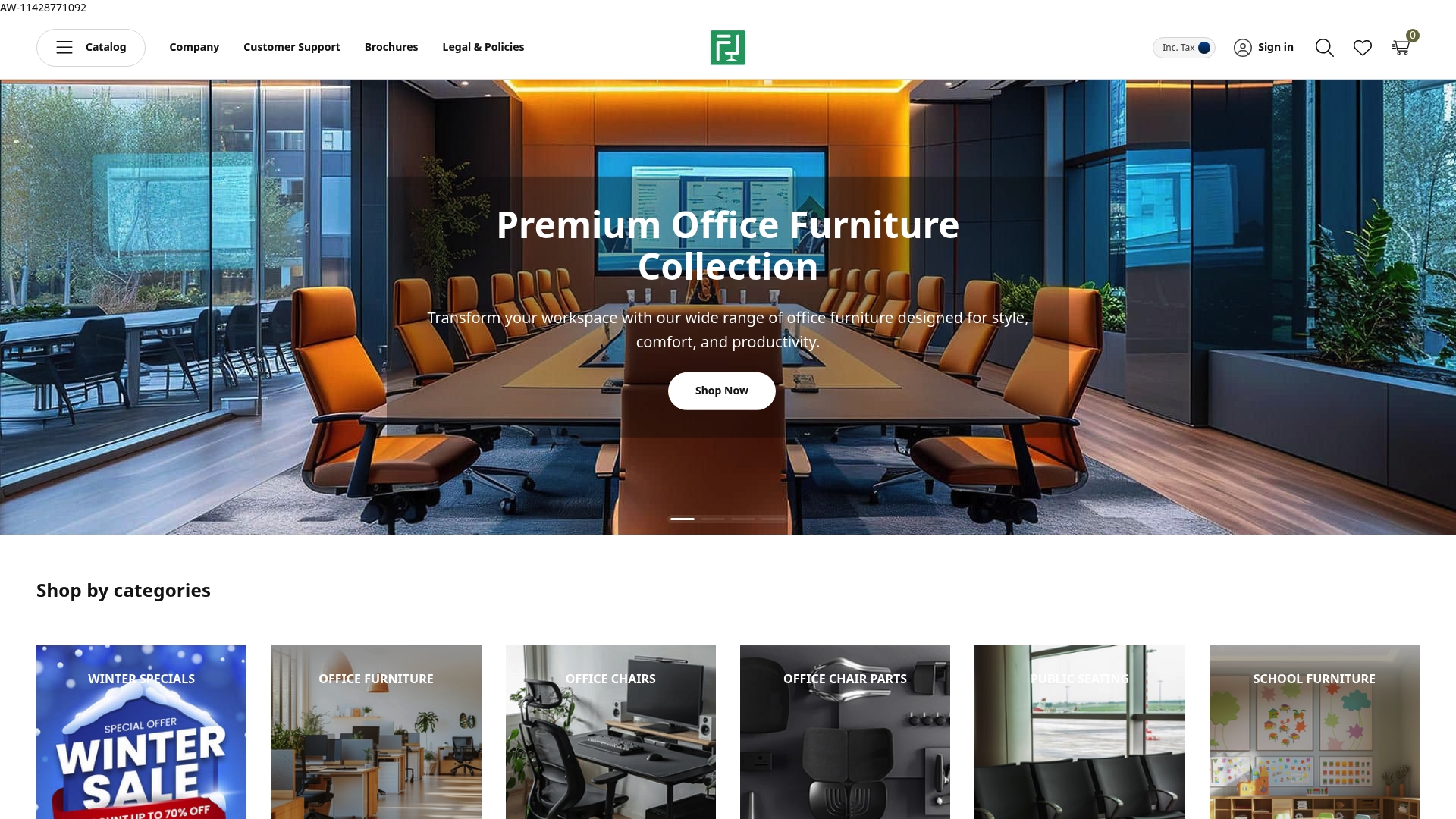Reconfigurable Workstations for Hybrid Teams in Southern Africa 2025
Jul 28, 2025
Reconfigurable Workstations for Hybrid Teams in Southern Africa 2025

Hybrid teams in Southern Africa are shaking up the way offices look and feel. Imagine this: teams that use reconfigurable workstations report up to 35 percent higher collaboration rates than those stuck with traditional desks. Most folks assume that all you need for hybrid work is a good internet connection. Turns out, the real secret to happy and productive teams might just be the shape-shifting furniture beneath their laptops.
Table of Contents
- Why Hybrid Teams Need Reconfigurable Workstations
- Key Features of Modern Reconfigurable Workstations
- Best Setup Ideas for Different South African Workplaces
- Choosing the Right Workstation for Your Business
Quick Summary
| Takeaway | Explanation |
|---|---|
| Reconfigurable workstations enhance team flexibility | They allow rapid workspace customization for different work styles in hybrid environments. |
| Focus on employee well-being | Ergonomic designs reduce strain, improving comfort and job satisfaction. |
| Incorporate intelligent technology | Systems like smart sensors help manage workspace effectively and adapt to team needs. |
| Prioritize sustainable practices | Use recyclable materials and modular designs to minimize waste and support a circular economy. |
| Continuous workspace evaluation is essential | Regular assessments ensure workstations meet evolving organizational demands and enhance productivity. |

Why Hybrid Teams Need Reconfigurable Workstations
The modern workplace is undergoing a radical transformation, with hybrid work models becoming the new standard for businesses across Southern Africa. Reconfigurable workstations have emerged as a critical solution for organizations navigating the complex landscape of flexible work arrangements. These innovative workspace solutions address the unique challenges faced by teams that split their time between remote and in-office environments.
Adapting to Dynamic Work Environments
Harvard Business Review reveals that hybrid teams struggle with maintaining collaboration and team cohesion. Reconfigurable workstations provide a strategic response to these challenges by offering unprecedented flexibility. Unlike traditional fixed office setups, these dynamic workspaces can be quickly transformed to support various work styles and team configurations. Whether a team needs collaborative spaces for group brainstorming or individual focus areas for concentrated work, reconfigurable workstations can be instantly adapted to meet changing needs.
The ability to rapidly reconfigure workspace layouts addresses several critical workplace demands. Teams can create collaborative zones for in-person meetings, break down spaces for smaller group interactions, or establish individual workstations that support focused work. This adaptability is particularly crucial for hybrid teams that require seamless transitions between different work modes and team compositions.
Enhancing Productivity and Employee Well-being
Research from the National Institutes of Health highlights the significant impact of workspace design on employee productivity and well-being. Reconfigurable workstations go beyond mere flexibility, offering ergonomic solutions that support employee health and performance. These adaptive workspace solutions allow organizations to create environments that can be tailored to individual employee needs, reducing physical strain and improving overall workplace comfort.
The psychological benefits are equally important. Employees working in flexible environments report higher levels of job satisfaction and engagement. The ability to choose and modify their workspace empowers team members, creating a sense of autonomy and control that is often missing in traditional office settings. For hybrid teams that may feel disconnected due to remote work arrangements, reconfigurable workstations provide a tangible solution to rebuild connection and collaborative spirit.
Future-Proofing Workplace Design
Investing in reconfigurable workstations is more than a temporary solution. It represents a forward-thinking approach to workplace design that anticipates the evolving nature of work. As businesses continue to embrace hybrid models, the ability to quickly adapt physical spaces becomes a competitive advantage. Organizations can reduce real estate costs, optimize space utilization, and create more dynamic and responsive work environments.
Reconfigurable workstations represent a strategic investment in workplace flexibility. They demonstrate an organization’s commitment to employee well-being, technological adaptability, and innovative work practices. For hybrid teams in Southern Africa, these adaptive workspace solutions are not just a trend but a necessary evolution in how we conceptualize and design productive work environments.
Key Features of Modern Reconfigurable Workstations
Modern reconfigurable workstations represent a sophisticated fusion of technology, ergonomics, and flexible design principles. These advanced workspace solutions are engineered to meet the complex demands of hybrid work environments, offering unprecedented adaptability and functionality for contemporary teams.
Intelligent Space Management Technologies
Research from the Dataspace project reveals groundbreaking approaches to workspace configuration. Modern reconfigurable workstations now incorporate sophisticated technologies that enable dynamic spatial transformations. These systems utilize robotic mechanisms, digital interfaces, and smart sensors to instantly reshape workspace layouts, supporting various work modes from collaborative group sessions to individual focused work.
Intelligent desk booking systems have become a critical feature of these advanced workstations. Studies in sustainable workplace design demonstrate how these digital platforms allow employees to pre-plan their workspace interactions. Workers can now see real-time occupancy, reserve specific workstations, and understand team member locations, dramatically improving coordination and resource management.
Ergonomic and Technological Integration
Industry 5.0 research highlights the emergence of human-centric workstation designs that seamlessly integrate cutting-edge technologies. These advanced workstations are equipped with embedded sensors that monitor environmental conditions, track ergonomic performance, and provide real-time feedback on workspace optimization. Digital twin technologies create virtual replicas of physical workspaces, enabling precise configuration and predictive maintenance.
Ergonomic features have evolved beyond traditional adjustable furniture. Modern reconfigurable workstations now include integrated power management systems, wireless charging stations, adjustable height mechanisms, and modular components that can be quickly repositioned. These design elements support individual comfort while maintaining overall workspace flexibility.
Sustainable and Adaptive Design Principles

Sustainability has become a core consideration in reconfigurable workstation design. Manufacturers are increasingly utilizing recyclable materials, implementing energy-efficient technologies, and creating modular components that extend product lifecycles. The ability to reconfigure and repurpose workspace elements reduces waste and supports circular economy principles.
Adaptive design principles now prioritize multifunctionality. A single workstation can transform from an individual workspace to a collaborative hub, from a presentation area to a private meeting zone. This versatility is achieved through innovative engineering that allows quick, tool-free reconfigurations, enabling organizations to maximize their spatial resources efficiently.
The evolution of reconfigurable workstations represents more than a technological upgrade. It signifies a fundamental reimagining of how we conceptualize workplace design, prioritizing human experience, technological integration, and organizational agility. As hybrid work continues to reshape professional landscapes, these intelligent workspace solutions will play an increasingly critical role in supporting dynamic, responsive, and innovative work environments.
To help you quickly compare the main features of modern reconfigurable workstations, here’s a summary table highlighting design pillars and their benefits.
| Design Pillar | Key Features | Benefits |
|---|---|---|
| Intelligent Space Management | Smart sensors, robotic mechanisms, desk booking systems | Real-time adaptability, resource efficiency |
| Ergonomic Integration | Embedded environmental sensors, digital twins, adjustable elements | Improved comfort & health, data-driven use |
| Tech Integration | Power management, wireless charging, robust connectivity | Seamless device use, future-ready |
| Sustainable/Modular Design | Recyclable materials, modular parts, multifunctional configurations | Reduced waste, easy upgrades, longevity |
Best Setup Ideas for Different South African Workplaces
Creating effective hybrid workplace configurations requires nuanced strategies tailored to specific organizational contexts. Southern African businesses must develop flexible workspace solutions that accommodate diverse work styles, technological requirements, and industry-specific needs.
Corporate Office Configurations
University of Washington research provides critical insights into designing inclusive hybrid work environments. Corporate offices should prioritize creating adaptable spaces that support seamless communication between on-site and remote team members. This involves establishing dedicated collaboration zones with advanced audio-visual technologies, enabling high-quality virtual interactions.
Effective corporate setups typically incorporate modular workstations that can be quickly reconfigured for different team sizes and project requirements. Explore our innovative workspace solutions for optimizing office layouts that promote flexibility and collaboration. Implementing hot-desking systems and creating technology-enabled meeting spaces can help organizations maximize spatial efficiency while supporting hybrid work models.
Technology and Manufacturing Environments
Research from software development workplace studies highlights the importance of co-designing workspace experiences that enhance productivity. In technology and manufacturing sectors, reconfigurable workstations must integrate specialized equipment, safety considerations, and collaborative technologies.
Smart workstations in these environments should feature robust connectivity options, integrated power management systems, and ergonomic designs that support complex technical tasks. Movable workbenches, adjustable equipment mounts, and modular storage solutions enable teams to quickly adapt spaces for different projects, machinery configurations, and team collaboration needs.
Educational and Training Spaces
EDUCAUSE Review insights emphasize creating inclusive learning environments that support both in-person and remote participants. Educational institutions and training centers require flexible spaces that can seamlessly transition between lecture, workshop, and collaborative learning modes.
Ideal setups include multi-functional furniture with integrated technology, allowing quick transformations between individual study areas and group learning zones. Wireless connectivity, adjustable display screens, and modular seating arrangements enable educators to create dynamic learning environments that accommodate diverse teaching methodologies and student interaction needs.
Implementing these strategic workspace configurations requires a holistic approach that considers technological infrastructure, organizational culture, and specific workplace dynamics. Southern African businesses must view reconfigurable workstations not merely as furniture solutions but as strategic tools for enhancing collaboration, productivity, and employee engagement across diverse professional environments.
Below is a comparison table outlining reconfigurable workstation priorities for three major workplace types mentioned in the article.
| Workplace Type | Configuration Priorities | Key Technologies/Features |
|---|---|---|
| Corporate Office | Modular desking, collaboration zones, AV for remote meetings | Hot-desking, smart booking, audio-visual systems |
| Technology/Manufacturing | Integrate equipment, safety, flexible layouts | Robust connectivity, movable benches, ergonomic gear |
| Educational/Training | Multi-mode setups, transition between group and individual learning | Modular furniture, wireless displays, e-learning |
Choosing the Right Workstation for Your Business
Selecting the ideal reconfigurable workstation requires a strategic approach that considers organizational needs, team dynamics, and long-term business objectives. Southern African businesses must navigate a complex landscape of workplace design to create environments that foster productivity, collaboration, and employee well-being.
Assessing Organizational Workspace Requirements
Research on hybrid workplace co-design emphasizes the importance of understanding an organization’s unique work patterns and collaborative needs. Businesses should conduct comprehensive assessments that examine team size, work modes, technological requirements, and future growth projections. This analysis forms the foundation for selecting reconfigurable workstations that can adapt to evolving workplace dynamics.
Key considerations include team composition, frequency of in-person and remote work, primary work activities, and specific industry demands. Check out our workspace optimization guide for detailed insights into matching workstation solutions with organizational needs. Factors such as team collaboration intensity, individual focus requirements, and technological integration play crucial roles in determining the most suitable workstation configurations.
Evaluating Workstation Features and Flexibility
Collaborative workspace research highlights the critical importance of selecting workstations that support diverse work styles and collaborative practices. Businesses should prioritize solutions that offer:
- Modular design allowing quick reconfiguration
- Integrated technology support
- Ergonomic considerations
- Scalable and adaptable layouts
- Robust connectivity options
The ideal workstation goes beyond mere furniture. It should serve as a dynamic platform that can transform to meet changing team needs, support various work modes, and facilitate seamless collaboration between on-site and remote team members.
Implementation and Continuous Optimization
Research from university collaborative workspace development underscores the importance of ongoing evaluation and adaptation. Implementing reconfigurable workstations is not a one-time solution but an iterative process that requires continuous assessment and refinement.
Businesses should establish feedback mechanisms to understand how workstations are being used, identify potential improvements, and ensure the workspace continues to meet evolving organizational needs. This might involve regular team surveys, utilization tracking, and periodic workspace audits to optimize configuration and functionality.
Choosing the right reconfigurable workstation is a strategic decision that extends beyond immediate practical considerations. It represents an investment in organizational culture, employee experience, and future workplace flexibility. Southern African businesses that approach this selection process with careful analysis, user-centered design, and a forward-thinking perspective will create workspaces that drive innovation, collaboration, and sustained productivity.
Frequently Asked Questions
What are reconfigurable workstations?
Reconfigurable workstations are flexible office furniture setups that can be quickly adjusted or transformed to support different work styles and team configurations, making them ideal for hybrid teams.
How do reconfigurable workstations enhance team collaboration?
These workstations allow for rapid customization of workspace layouts, enabling teams to create collaborative spaces for group activities or quiet areas for focused work, which significantly boosts collaboration rates.
What benefits do reconfigurable workstations offer for employee well-being?
They provide ergonomic designs that reduce physical strain, improve comfort, and allow employees to tailor their work environment, leading to higher job satisfaction and engagement.
How can businesses implement reconfigurable workstations effectively?
Businesses should assess their unique workspace requirements, evaluate workstation features for flexibility, and establish continuous feedback mechanisms to ensure the workstations meet evolving needs.
Transform Your Hybrid Space with Office Stock Solutions
Hybrid teams across Southern Africa face a real struggle to keep up with fast-changing work routines and constant reconfigurations. The article clearly shows the pain of fixed office setups, low flexibility, and the impact these have on both productivity and team morale. Your business needs a solution that makes workspace shifts easy, supports ergonomics, and keeps employees connected—exactly what Office Stock delivers.

Are you ready to build an office that adapts to your team’s every need? Visit Office Stock and explore how our range of premium desks, ergonomic chairs, and modular storage will help you move past outdated setups. Every product is designed for easy reconfiguration, long-term durability, and style. Don’t let your team settle for less—upgrade now and unlock the smart, flexible office environment your hybrid workforce deserves. Start browsing at Office Stock today.
